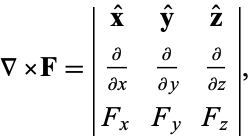In calculus we compute derivatives of real functions of a real variable. In the case of functions of a single variable
y = f(x)
we compute the derivative of y with respect to x. In the case of a function of several variables
y = f(x1, x2, ... , xn)
we can compute the derivative of y with respect to any one of the independent variables, viewing the others as fixed.
In vector analysis we compute derivatives of vector functions of a real variable; that is we compute derivatives of functions of the type
F(t) = f1(t) i + f2(t) j + f3(t) k
This function can be viewed as describing a space curve. Intuitively it can be regarded as a position vector, expressed as a function of t, that traces out a space curve with increasing values of t. Expressed in different notation it is the function
R(t) = x(t) i + y(t) j + z(t) k
Vector differentiation is almost the same as what we do in Calculus, we just get the derivative of the function of i, j and k. Thus,R(t) = x(t) i + y(t) j + z(t) k
In the case of a vector function of several variables, we can compute the partial derivatives of the function with respect to a particular independent variable in the same way we do in ordinary calculus by considering all other independent variables to be fixed parameters. Thus
Differential Geometry (Frenet-Serret Formulas)
These vector differential equations relate inherent properties of a parametrized curve. In matrix form, they can be written as
![[T^.; N^.; B^.]=[0 kappa 0; -kappa 0 tau; 0 -tau 0][T; N; B],](http://mathworld.wolfram.com/images/equations/FrenetFormulas/NumberedEquation1.gif)
where is the unit tangent vector,
is the unit tangent vector,  is the unit normal vector,
is the unit normal vector,  is the unit binormal vector,
is the unit binormal vector,  is the torsion and
is the torsion and  is the curvature.
is the curvature.
In summary,

GRADIENT
These vector differential equations relate inherent properties of a parametrized curve. In matrix form, they can be written as
![[T^.; N^.; B^.]=[0 kappa 0; -kappa 0 tau; 0 -tau 0][T; N; B],](http://mathworld.wolfram.com/images/equations/FrenetFormulas/NumberedEquation1.gif)
where
In summary,

GRADIENT
The gradient of a scalar field is a vector field which points in the direction of the greatest rate of increase of the scalar field, and whose magnitude is the greatest rate of change.
The gradient of a scalar function is denoted by the DEL operator (also called Nabla):


DIVERGENCE and CURL
The divergence of a vector field is denoted by
is denoted by  . The physical significance of the divergence of a vector field is the rate at which "density" exits a given region of space.
. The physical significance of the divergence of a vector field is the rate at which "density" exits a given region of space.

The curl of a a vector field, denoted or
or  is defined as the vector field having magnitude equal to the maximum "circulation" at each point and to be oriented perpendicularly to this plane of circulation for each point. More precisely, the magnitude of
is defined as the vector field having magnitude equal to the maximum "circulation" at each point and to be oriented perpendicularly to this plane of circulation for each point. More precisely, the magnitude of  is the limiting value of circulation per unit area.
is the limiting value of circulation per unit area.

Sources:
Wolfram Mathworld
Solitary Road
Wikipedia
The gradient of a scalar function is denoted by the DEL operator (also called Nabla):
For cylindrical coordinates,
and for spherical coordinates,
DIVERGENCE and CURL
The divergence of a vector field
The curl of a a vector field, denoted

Sources:
Wolfram Mathworld
Solitary Road
Wikipedia









1 people rectified:
it's cool, i want to learn this.
Post a Comment